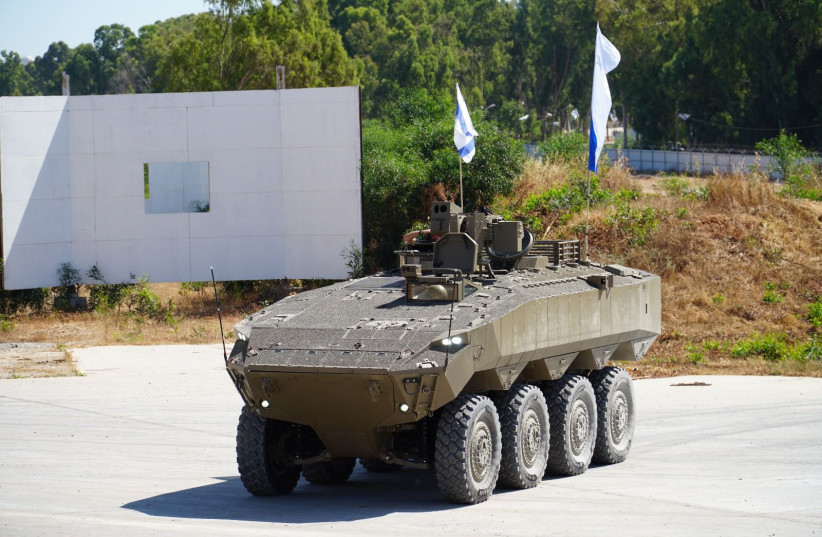The first Eitan armored personnel carrier (APC) will be delivered to the IDF’s Nahal infantry brigade in the near future for operational use, according to a statement from a Defense Ministry spokesman. Initial serial production was completed over the weekend and the Eitan rolled off of the production line at the Merkava factory, the statement added.
Old APCs put soldiers in danger
Serial production of the Eitan began in early 2020 in a project based on lessons learned from fighting Hamas in the Gaza Strip during Operation Protective Edge in 2014.
Hamas killed seven IDF soldiers in the operation by firing a missile at an M113 APC. After this fatal attack, 30 reservists told their commanders that they would not enter Gaza in the M113 — an APC that the US Army designed in the 1960s and used in the Vietnam War.
Compared to other APCs, the Eitan was designed to give IDF soldiers improved security, speed and mobility. The Eitan promises to achieve its goals. Boasting eight wheels and a 750-horsepower engine, it can reach speeds of 90 kph, maneuver in different types of terrain and remain operational for several days at a time.
What are the Eitan’s features?
As the IDF’s first wheeled APC, the Eitan has a significant advantage over other APCs given that it does not need to be hauled on other transportation vehicles to reach its destination. Wheels also allow the vehicle to be more maneuverable in dense urban areas like the Gaza Strip.

Elbit System’s Iron Fist active protection system will defend troops from incoming anti-tank missiles by intercepting them. The Iron Fist provides 360-degree protection in close-range scenarios in both open and urban environments, and uses independent optical sensors, tracking radar, launchers and countermeasure munitions to eliminate threats at a safe distance from the defended combat vehicles.
An unmanned turret with a FN MAG and 0.50-caliber heavy machine gun will provide the vehicle with plenty of firepower in addition to a 30-mm cannon with a 2.5 km. range.
Additional features, according to the statement, include peripheral cameras, touch monitors, and other technologies developed by a collaboration between security industries, IDF Ground Forces and the Defense Ministry’s Directorate of Defense Research and Development. To keep soldiers cool, the vehicle will also be air-conditioned.
A long process of development
The current Eitan was not developed overnight; it has been undergoing comprehensive tests since its reveal in 2016. Significant improvements have been made since then, such as a more protective body, upgraded suspension system and better steering.
In its current form, the Eitan is 8 metres long and 3 metres wide, weighing in at 30-35 tons. Around one million parts go into the vehicle along with 30 km. of welding wire, six km. of power and communications cables, and 70 liters of paint. Three crew members — a commander, gunner and driver — operate the vehicle that can hold nine other soldiers.
The Eitan will be incorporated into IDF combat units
IDF soldiers in the Nahal Brigade will be the first to receive the Eitan. The APC will then be gradually incorporated into other combat units, Brigadier-General Guy Paglin, head of the Tank and APC Directorate, said in the statement. As part of the IDF’s push to modernize its armored vehicles to replace the M113 APC, the Eitan will be a key asset to IDF soldiers.
“The development of new weapons allows us to replace old and less advanced technologies.”
Brigadier-General Guy Paglin, head of the Tank and APC Directorate
“The development of new weapons allows us to replace old and less advanced technologies,” Paglin explained, “thus promising that our soldiers are equipped with the best, most advanced defense equipment for all combat scenarios.”
Anna Ahronheim contributed to this report.
